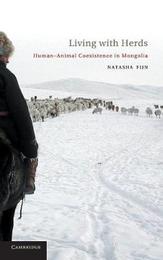
|
Living with Herds: Human-Animal Coexistence in Mongolia
Hardback
Main Details
| Title |
Living with Herds: Human-Animal Coexistence in Mongolia
|
| Authors and Contributors |
By (author) Natasha Fijn
|
| Physical Properties |
| Format:Hardback | | Pages:302 | | Dimensions(mm): Height 235,Width 158 |
|
| Category/Genre | Archaeology
Social impact of environmental issues |
|---|
| ISBN/Barcode |
9781107000902
|
| Classifications | Dewey:306.095173 |
|---|
| Audience | | Professional & Vocational | |
|---|
| Illustrations |
11 Tables, unspecified; 40 Halftones, unspecified; 40 Halftones, black and white; 12 Line drawings, black and white
|
|
Publishing Details |
| Publisher |
Cambridge University Press
|
| Imprint |
Cambridge University Press
|
| Publication Date |
11 April 2011 |
| Publication Country |
United Kingdom
|
Description
Domestic animals have lived with humans for thousands of years and remain essential to the everyday lives of people throughout the world. In this book, Natasha Fijn examines the process of animal domestication in a study that blends biological and social anthropology, ethology and ethnography. She examines the social behavior of humans and animals in a contemporary Mongolian herding society. After living with Mongolian herding families, Dr Fijn has observed through firsthand experience both sides of the human-animal relationship. Examining their reciprocal social behavior and communication with one another, she demonstrates how herd animals influence Mongolian herders' lives and how the animals themselves are active partners in the domestication process.
Author Biography
Natasha Fijn's research crosses often preconceived boundaries between human-nonhuman, nature-culture, domestic-wild, ethnography-ethology, and written ethnography-visual anthropology. She has a background in both wildlife and ethnographic filmmaking, including a postgraduate diploma in Natural History Film and Communication and she has worked on natural history documentaries that have been distributed worldwide. She completed a Master of Science in ethology at the University of Canterbury, New Zealand, focusing on animal cognition, predator-prey interactions and animal communication, and was subsequently employed by the University of Vienna to conduct field research investigating social learning in a mountain parrot, the kea. While conducting this research Natasha wrote three natural history books for children on native New Zealand birds: one on the kea and two on the pukeko. During this time she was involved with the filming of the BBC documentary on the kea, entitled 'Kea: The Smartest Parrot?' (2003). Natasha is passionate about communicating cross-species, cross-cultural ideas, not only in written form but also through other media, using film and photography as an integral part of demonstrating the results of her research. She completed her Ph.D. thesis in 2008 within the School of Archaeology and Anthropology at the Australian National University, Canberra. The field research for the thesis, and footage for a film that formed an integral part of this research, was obtained over twelve months in 2005, while she lived with two herding families in the Khangai mountains of Mongolia. This book is a result of her year of living with Mongolian herders and their herd animals.
Reviews'The author contextualises her ethnographic and auto-ethnographic research with reference to ethological studies as much as with anthropological and this approach is more than justified ... this book is a significant contribution for those engaged in the study of East and Central Asian cultures, as well as those interested in pastoralists and human-animal relationships more generally.' Journal of the Royal Asiatic Society
|